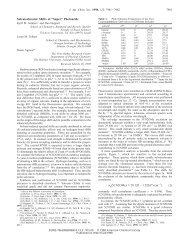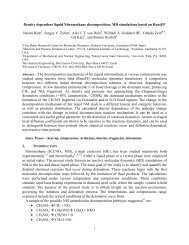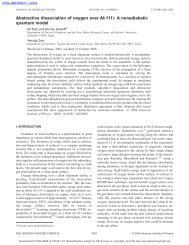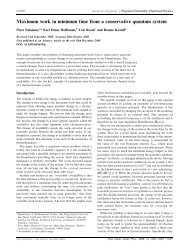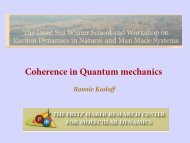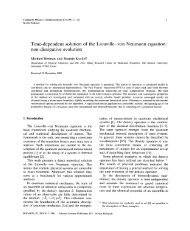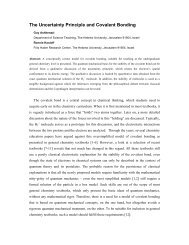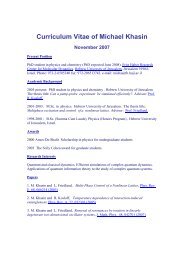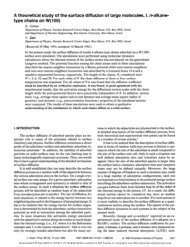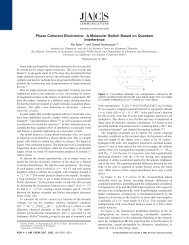BLYP MS-EVB2
BLYP MS-EVB2
BLYP MS-EVB2
You also want an ePaper? Increase the reach of your titles
YUMPU automatically turns print PDFs into web optimized ePapers that Google loves.
O 1X identity<br />
O 0 identity<br />
60<br />
50<br />
40<br />
30<br />
20<br />
10<br />
60<br />
50<br />
40<br />
30<br />
20<br />
10<br />
SUPPORTING ONLINE MATERIAL:<br />
Special Pair Dance and Partner Selection:<br />
Elementary Steps in Proton Transport in Liquid Water<br />
Omer Markovitch, Hanning Chen, Sergei Izvekov, Francesco Paesani, Gregory A. Voth<br />
and Noam Agmon*<br />
SP dance<br />
L o n g<br />
<strong>BLYP</strong><br />
Zundel<br />
Short<br />
5 6<br />
Time [ps]<br />
7<br />
Figure S1. The identity of the hydronium oxygen (bottom, black) and its nearest neighbor<br />
(top, red) during an exemplary 3 ps of <strong>BLYP</strong> and <strong>MS</strong>-<strong>EVB2</strong> trajectories. Note that <strong>BLYP</strong><br />
shows the “SP dance”, but not <strong>MS</strong>-<strong>EVB2</strong>, which exhibits many more successful PT<br />
events. Both trajectories show rapid fluctuations of the hydronium identity which are<br />
coupled, in the Zundel complex, to fluctuations in the identity of O1x.<br />
S 1<br />
600<br />
500<br />
400<br />
300<br />
200<br />
100<br />
0<br />
600<br />
500<br />
400<br />
300<br />
200<br />
100<br />
0<br />
<strong>MS</strong>-<strong>EVB2</strong><br />
10 11 12 13<br />
Time [ps]
g i (r)<br />
g i (r)<br />
4<br />
3<br />
2<br />
1<br />
0<br />
4<br />
3<br />
2<br />
1<br />
0<br />
<strong>BLYP</strong><br />
<strong>MS</strong>-<strong>EVB2</strong><br />
2.5 3.0 3.5 4.0 4.5 5.0<br />
S 2<br />
r [Å]<br />
g 0<br />
g 1x<br />
g 1yz<br />
Figure S2. Equilibrium O—O radial distribution functions for the hydronium (black)<br />
and its first-shell neighbors (1x − red & 1yz − green) using all time-frames from <strong>BLYP</strong><br />
and <strong>MS</strong>-<strong>EVB2</strong> trajectories.
g Short<br />
(r) 0<br />
g Long<br />
(r) 0<br />
4<br />
3<br />
2<br />
1<br />
0<br />
5<br />
4<br />
3<br />
2<br />
1<br />
EVB3<br />
< 5 fs<br />
600 fs<br />
> 500 fs<br />
> 400 fs<br />
> 300 fs<br />
S 3<br />
HCTH<br />
> 726 fs<br />
> 581 fs<br />
> 436 fs<br />
> 218 fs<br />
2.2 2.4 2.6 2.8 3.0<br />
r [Å]<br />
Figure S3. Conditional O—O radial distribution functions for the first solvation layer of<br />
the hydronium for trajectory segments of different lengths (indicated). From the long<br />
segments the first and last 50 fs were deleted. The RDFs for the Long intervals converge<br />
when their length > 300 fs. The RDFs for the Short intervals converge when their length<br />
g 0 (r)<br />
g 0 (r)<br />
g 0 (r)<br />
5<br />
4<br />
3<br />
2<br />
1<br />
0<br />
4<br />
3<br />
2<br />
1<br />
0<br />
4<br />
3<br />
2<br />
1<br />
0<br />
2.5 3.0<br />
r [Å]<br />
S 4<br />
Eq.<br />
Long<br />
Short<br />
f*L + (1-f)*S<br />
<strong>BLYP</strong><br />
<strong>MS</strong>-<strong>EVB2</strong><br />
q<strong>MS</strong>-EVB3<br />
Figure S4. Conditional O—O radial distribution functions for the hydronium using timeframes<br />
from long (blue) and short (cyan) trajectory segments from <strong>BLYP</strong>, <strong>MS</strong>-<strong>EVB2</strong><br />
and quantal <strong>MS</strong>-EVB3 trajectories. The yellow line shows a best fit to the equilibrium<br />
RDF (black, Fig. S2) using a linear combination of the two conditional RDFs with a<br />
factor f= 0.74 for <strong>BLYP</strong> and f=0.77 for <strong>MS</strong>-<strong>EVB2</strong>. The fit did not succeed for the q<strong>MS</strong>-<br />
EVB3 trajectory.
g 1X (r)<br />
g 1X (r)<br />
g 1X (r)<br />
4<br />
3<br />
2<br />
1<br />
0<br />
4<br />
3<br />
2<br />
1<br />
0<br />
4<br />
3<br />
2<br />
1<br />
0<br />
<strong>BLYP</strong><br />
<strong>MS</strong>-<strong>EVB2</strong><br />
q<strong>MS</strong>-EVB3<br />
2.5 3.0<br />
r [Å]<br />
Figure S5. Conditional O—O radial distribution functions for the hydronium nearest<br />
oxygen, O1x, using time-frames from long (blue) and short (cyan) trajectory segments<br />
from <strong>BLYP</strong>, <strong>MS</strong>-<strong>EVB2</strong> and quantal <strong>MS</strong>-EVB3 trajectories. The yellow line shows a best<br />
fit to the equilibrium RDF (black, Fig. S2) using a linear combination of the two<br />
conditional RDFs with a factor f= 0.74 For <strong>BLYP</strong> and f=0.77 for <strong>MS</strong>-<strong>EVB2</strong>. The fit did<br />
not succeed for the q<strong>MS</strong>-EVB3 trajectory.<br />
S 5<br />
Eq.<br />
Long<br />
Short<br />
f*L + (1-f)*S
g (r), |<br />
| δδδδ |<br />
| < ∆<br />
Z<br />
g (r), | δδ<br />
δδ<br />
|<br />
| > ∆<br />
E<br />
4<br />
3<br />
2<br />
1<br />
0<br />
5 Eigen<br />
4<br />
3<br />
2<br />
1<br />
0<br />
EVB3<br />
2.2 2.4 2.6 2.8<br />
r [Å]<br />
Figure S6. The RDFs for Zundel and Eigen cations for various cutoff distances, ∆ (in Ǻ),<br />
in the geometric criterion of Marx et al. [23,41]. Our conditional RDFs for small and<br />
large non-transfer intervals are shown for comparison (black lines). The comparison<br />
shows that the best choice of cut-off distances is ∆Z ≤ 0.1 Ǻ and ∆E = 0.2 Ǻ.<br />
S 6<br />
Zundel<br />
∆ Z =<br />
0.01<br />
0.1<br />
0.2<br />
0.3<br />
0.5<br />
∆<br />
∆<br />
∆ E =<br />
0.5<br />
0.4<br />
0.3<br />
0.2<br />
0.1
g (r)<br />
g (r)<br />
g (r)<br />
g (r)<br />
g (r)<br />
4<br />
2<br />
0<br />
4<br />
2<br />
0<br />
4<br />
2<br />
0<br />
4<br />
2<br />
0<br />
4<br />
2<br />
0<br />
HCTH<br />
+5 fs<br />
−5 fs<br />
−10 fs<br />
−20 fs<br />
−40 fs<br />
2.3 2.4 2.5 2.6 2.7 2.8 2.9 3.0<br />
r [Å]<br />
Figure S7. Time-dependent radial distribution functions for the hydronium [g0(r;t), in brown] and<br />
its nearest oxygen [g1x(r;t), in magenta] just before a proton hopping event in a HCTH simulation.<br />
The dashed and dotted lines show the same RDFs from the ensembles of long (Eigen, blue) and<br />
short (Zundel, cyan) trajectory segments. The larger noise for AIMD trajectories is due to their<br />
limited duration, dictated by their significantly greater computational cost.<br />
S 7<br />
g 0<br />
g 1x<br />
g 0 -Short<br />
g 1x -Short<br />
g0 g1x g0-Long g 1x -Long
g (r)<br />
g (r)<br />
g (r)<br />
g (r)<br />
4<br />
2<br />
0<br />
4<br />
2<br />
0<br />
4<br />
2<br />
0<br />
4<br />
2<br />
4<br />
2<br />
g (r) 0<br />
0<br />
<strong>BLYP</strong><br />
2.3 2.4 2.5 2.6 2.7 2.8 2.9 3.0<br />
S 8<br />
+5 fs<br />
−5 fs<br />
−10 fs<br />
−20 fs<br />
−40 fs<br />
r [Å]<br />
g0 g1x g0-Short g 1x -Short<br />
g 0<br />
g 1x<br />
g 0 -Long<br />
g 1x -Long<br />
Figure S8. Same as Figure S5 for an AIMD simulation with the <strong>BLYP</strong> functional.
g (r)<br />
g (r)<br />
g (r)<br />
g (r)<br />
g (r)<br />
4<br />
2<br />
0<br />
4<br />
2<br />
0<br />
4<br />
2<br />
0<br />
4<br />
2<br />
0<br />
4<br />
2<br />
0<br />
<strong>MS</strong>-<strong>EVB2</strong><br />
2.3 2.4 2.5 2.6 2.7 2.8 2.9 3.0<br />
S 9<br />
+5 fs<br />
−5 fs<br />
−10 fs<br />
−20 fs<br />
−40 fs<br />
r [Å]<br />
Figure S9. Same as Figure S5 for a <strong>MS</strong>-<strong>EVB2</strong> simulation.<br />
g 0<br />
g 1x<br />
g 0 -Short<br />
g 1x -Short<br />
g0 g1x g0-Long g 1x -Long



